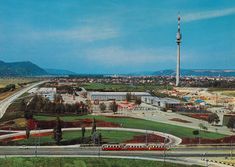The new Danube Tower with its futuristic revolving restaurant, a chairlift that glided along above the flower beds, miniature trains wending their way between rose gardens, modern pavilions and the newly laid-out "Iris Lake" – these were just a few of the attractions for visitors to enjoy at the 1964 Vienna International Garden Show (Wiener Internationale Gartenausstellung, WIG).
The opening of what was then Europe's largest garden show was celebrated 50 years ago, in April 1964. About 2.3 million people visited the WIG, turning it into a landmark event in the history of post-war Vienna that left its traces in the collective memory and, above all, gave rise to one of the biggest 20th-century parks in Vienna, the "Donaupark". One objective of the project was to improve and develop a hitherto neglected area on the "wrong side of the Danube". The Garden Show park was developed on what used to be the Bruckhaufen waste dump, an informal settlement called Bretteldorf and the Kagran military shooting range that had been used as an execution site during the Nazi era.
The WIG was not only a welcome urbanistic solution for a "problem zone" in relative proximity to the city centre, it also embodies a paradigm shift in post-war urban planning. Politicians of the time emphasised the important social function of urban green spaces as a counterweight to the ever more densely built-up city. New parks were created to turn Vienna into a modern metropolis where, in the words of Mayor Franz Jonas, "many healthy, strong and handsome people can build a better world." The Garden Show buildings and attractions, which included a 41-metre high greenhouse tower, testified to the willingness of "cosmopolitan Vienna" to embrace modernity and to the as yet undiminished faith in technological progress.
The exhibition looks at the Vienna International Garden Show in relation to utopian visions of urban planning and to Vienna's efforts to groom its image in the post-war period, as well as presenting contemporary trends in garden design.
The final section is dedicated to the various uses to which the WIG premises were put after the show and the modifications the park has undergone since. Key items on display include contemporary photographs, models, films, posters, and the personal memories of Viennese people.
02.04.2014

